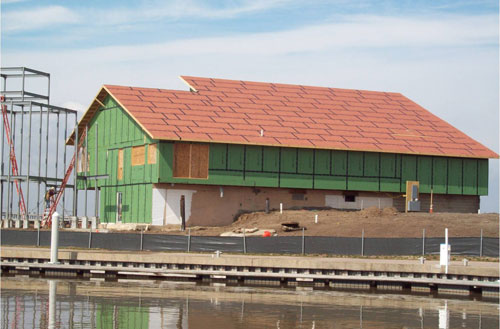High-Performance Wood-Framed Roofs
Considerations in Designing Roof Systems
Designing high-performance roofs are a function of a complex interplay of key factors and special considerations from roof pitch to environmental loads and construction techniques in hurricane-prone areas.
Roof Pitch. Roof pitch, or slope, is a main consideration in roof design and is determined by the vertical rise in inches for every horizontal twelve inch length, which is known as the run. A roof with x rise/12 run slope means that for every 12 inches horizontally, it rises x inches. According to Waterproof Magazine, pitches for common roof types include:
- Flat Roof: Less than 2/12
- Low Slope: 2/12-4/12
- Conventional Slope Roof: 4/12-9/12
- Steep Slope: 9/12 and higher
 |
|
Photo: Huber Engineered Woods Pitched roofs require little maintenance and have long service lives. |
While the slope has an effect on the roof style and materials used as well as the space in the building’s interior, the primary purpose of sloping a roof is to shed water. Many roofing contractors maintain that pitched roofs are generally more expensive than their lower sloped counterparts, but they also last longer, require much less maintenance, and withstand water better. Felt or synthetic underlayments are usually adequate—options that narrow on flatter roofs. Typically used for commercial applications, flat roofs are cheaper to build, but require constant maintenance, and are prone to roof leaks,contractors say. With a heavy rain or snowfall there is a risk of ponding from the added weight placed on a flat roof; architects must adjust their designs accordingly. Ethylene propylene diene monomer (EPDM) membranes are now used in many low- or flat-roof applications to provide protection from weathering. In many situations, designers choose to use stiff, water resistant subflooring panels beneath the EPDM. High performing osb and plywood provide greater resistance to ponding loads. Resistance to ponding loads is a major consideration in flat roof design.
Environmental Loads. Beside the usual dead and live load considerations, roof designers must address environmental loads. Snow loads on roofs vary according to a variety of complex factors including the roof itself, climate, snow, ice and exposure to wind. Flat-roofed buildings present the greatest danger of collapse due to snow load as they do not allow the snow to slide off, and do not drain well during snowmelt. The American Society of Civil Engineers (ASCE) 7-05 provides guidance for determining snow loads based on specific criteria. Underlayments take on an added importance in these situations. Felt and many synthetics may not be able to offer the moisture protection necessary as roofs build up with ice dams and heavy dense snow.
Another concern with snow is exposure of the wood framing in an unfinished house. Dusty Bitton, owner of Pinetop Custom Homes, is located in McCall, Idaho, which has the highest average snowfall in Idaho and only a 5-month building season. “At times we are unable to complete our builds before the heavy snowfall hits and must depend on moisture-resistant products to prevent any issues until we can continue the building process the next spring,” stated Bitton. “I began building a home last November using the wood structural panels with built-in moisture resistance that were exposed through May. Although the homeowner was worried, the strength and moisture barriers of the products prevented any issues, and we were able to resume building without any delay due to rework.”
Wind damage, too, is a common cause of roofing failures. The design load for wind uplift of a roof is a complex formula that is determined by such factors as roof structure, slope, wind speed, building height, roof areas, building terrain, building type and building openings. Calculators exist to determine the design wind loads for the roof area's field, perimeter and corner zones, and minimum recommended design wind-resistance loads based on the specific building and climate parameters. Once calculated, the force can be used to influence the materials selected for the roof so it cannot be torn from the building in strong winds. If you have any questions about calculating wind pressures, consult an engineer or your local building official.
The Federal Emergency Management Agency (FEMA) has produced a series of 37 fact sheets to provide technical guidance and recommendations aimed at improving the performance of buildings subject to flood and wind forces in coastal environments. Known as FEMA 499, although considered good practice in coastal regions, these recommendations are not requirements unless the local code references the document. One FEMA recommendation suggests taping sheathing panel seams to provide better protection against water infiltration if the roof covering ever blows off. If a storm ever blows the finished roof covering off, any loose laid underlayment, like felt, will blow away with it. This exposes the panel seams and creates a direct path for water intrusion into the house. This can lead to a tremendous amount of water damage inside the home. Taping panel seams as recommended by FEMA protects the home from this type of damage. In the experience of North Carolina custom home builder, John Paul Corey of East Carolina Construction, the taped combination panels held up very well on his projects after Hurricane Irene battered the North Carolina coast in August 2011, producing winds in excess of 80 miles per hour. “Other projects in the area had either tar paper on the roof, or building wrap on the exterior, and 60 to 70 percent of their materials blew off during the storm that then had to be replaced,” notes Corey.









